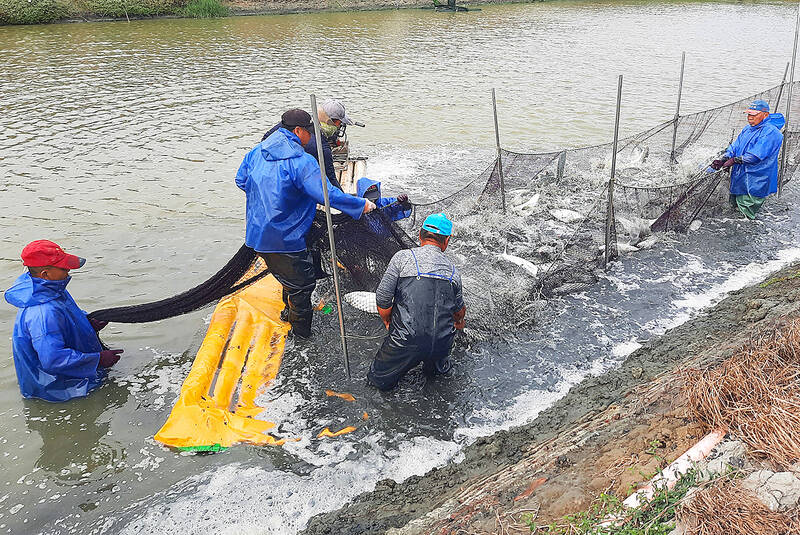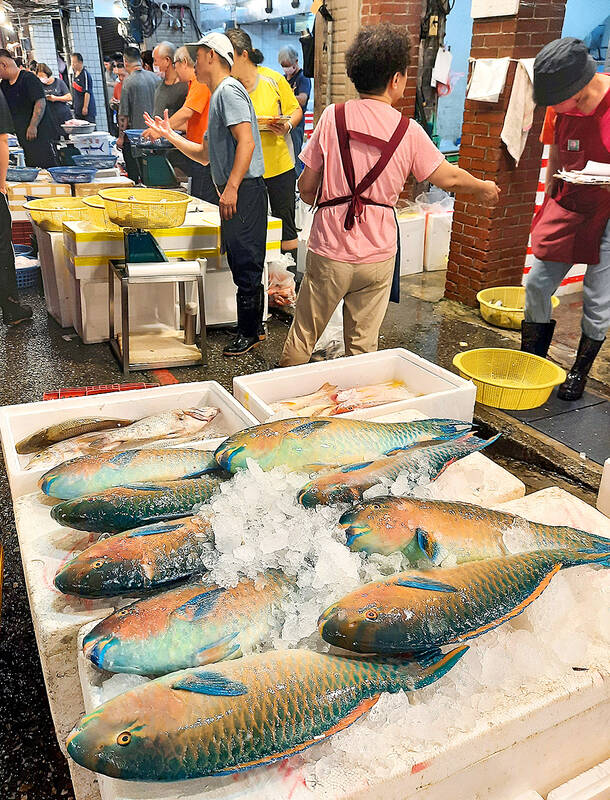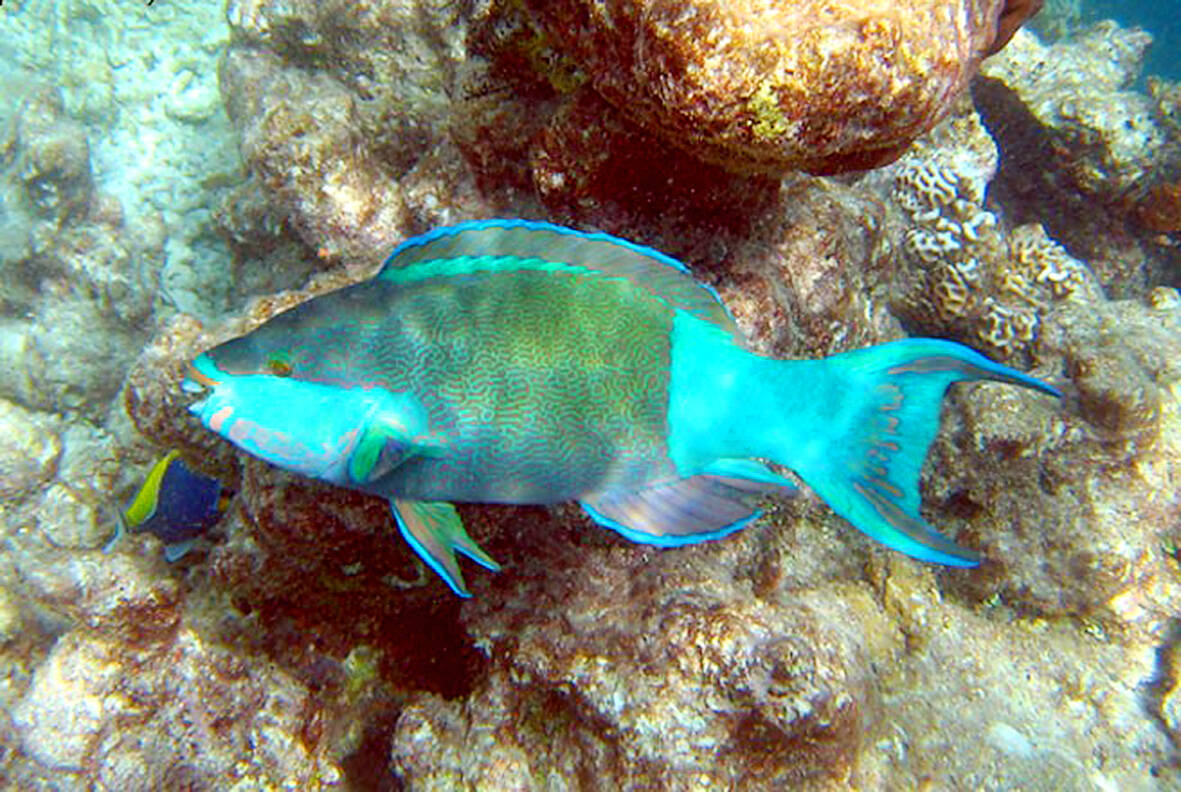There’s not much a resident of this country can do to get Taiwan Power Co (Taipower) to burn less coal. The state-owned company has a monopoly on the distribution of electricity to households. Environmentally-conscious individuals can’t switch to another supplier, and living off-grid isn’t an option if you’re on the ninth floor of a New Taipei City apartment block.
When it comes to nudging the seafood industry in the right direction, however, it’s a different kettle of fish. By avoiding overexploited species and problematic retailers, ordinary consumers can use their dollars to encourage those who extract food from the oceans to do the right thing — so long as they have access to accurate information.
SEAFOOD GUIDES

Photo: Steven Crook
Providing clear guidance is the principal goal of the Seafood Guide Taiwan (臺灣海鮮選擇指南, fishdb.sinica.edu.tw/seafoodguide/), a Chinese-language online directory maintained as part of Academia Sinica’s Fish Database of Taiwan. The sixth edition of the guide, published in April 2023, covers 102 species often consumed in Taiwan.
Another useful Chinese-language resource for Taiwan residents who adore fish, shellfish, roe and/or seaweed but hope to minimize their impact on maritime ecosystems is Greenpeace’s Chinese-language Sustainable Seafood Shopping Manual (永續海鮮規範手冊, cloud.greentw.greenpeace.org/cwf-seafood-handbook).
Seafood Guide Taiwan assigns each featured species one of three colors: green, meaning wild stocks are abundant and fishing methods don’t harm the environment; amber, indicating it should be consumed only in moderate quantities and with discretion; or red, in which case it should be avoided.

Photo: Steven Crook
The guide greenlights the consumption of mahi-mahi (also known as the common dolphinfish) because it’s a widely distributed migratory species and its population quickly recovers. Amber species include mantis shrimp; previously it was in the red category, and the guide warns that “wild resources continue to decline [and] any increase in consumer demand could be problematic.”
Among the 25 red species are: wild grouper (“overfishing has led to a sharp decline of wild stocks… it takes a long time for the population to recover”); large yellow croaker (overfished and, because it’s sourced far from Taiwan, it has a substantial carbon footprint); and coconut crab (protected by the Wildlife Conservation Act).
The guide asks consumers to favor sea creatures near the bottom of the oceanic food chain, such as small fish (mackerel, sardines and herring) and bivalve molluscs (clams, mussels and oysters).

Photo: Wikipedia
Consumers should also avoid frequent consumption of large predatory fish higher up the food chain, like tuna and sharks, and not just because those species are slow to reproduce and their disappearance is likely to disrupt the entire food web. As a result of bioaccumulation (the way in which toxins gradually build up in the bodies of creatures that live longer) and biomagnification (when large fish eat small fish, they ingest whatever toxins are in the latter), predatory fish often contain worrying amounts of mercury and other heavy metals.
SHOP LOCAL
When they can, Taiwanese buyers should purchase local-sourced delicacies, instead of seafood like squid that’s been transported thousands of kilometers. The reasoning is straightforward and it applies to all types of food, not just seafood: What’s produced far away almost always has a greater carbon footprint than local food, and carbon emissions are a direct cause of ocean acidification.
When it comes to farmed fish, consumers should seek out seafood that bears a traceability label and sustainability certification. And if they can, they should opt for fish raised on plant-based feed over those raised on fishmeal. As explained in a previous column (“Can we eat fish and still have healthy oceans?” on July 23, 2025), a fifth of the global catch doesn’t end up in human stomachs, but gets turned into feed for fish and livestock farms.
The average consumer can’t be expected to judge where in the food chain the fish they’re thinking of buying fits. But one rule is easy to follow: If there’s a choice between a fish with a silvery or whitish body, and another that’s colorful, go for the former. The majority of fish with vibrant colors inhabit coral reefs, and their removal can undermine these fabulous and important ecosystems.
Liao Yun-chih (廖運志), the primary contributor to the Seafood Guide Taiwan, says he’d like to see assessments of seafood resources updated every three to five years, “to reflect current data and ensure that recommendations remain relevant and accurate,” but he concedes there are challenges.
“First, assessments require substantial data collection and expert evaluation, which are time-consuming and often underfunded. There’s also a limited number of specialists with the necessary interdisciplinary expertise in fisheries, conservation and market analysis,” says Liao, now an associate professor at the University of Taipei’s Department of Earth and Life Sciences
Maintaining a scientifically credible and up-to-date seafood guide shouldn’t be prohibitively expensive, he adds, but it would require “institutional commitment and collaboration — something that’s slowly improving but not yet in place.”
AWARENESS
Liao feels public awareness of seafood sustainability in Taiwan is limited compared to Japan and the US, “but it is growing.” Cultural and economic factors are at play, he explains. “Seafood is an everyday part of life here, often purchased at traditional markets where labeling and traceability are minimal. That said, younger generations and urban consumers are becoming more receptive to these issues, especially when the information is made accessible and locally relevant,” he says.
Seafood labeling took a major step forward in 2018 with the launch of the homegrown Ocean Heart ecolabel (海洋之心生態標章). Since then, 2,016 restaurants and catering businesses have obtained Ocean Heart certification, which is also available to fishing-vessel operators, wholesalers and food processing companies.
There’s considerable overlap between eateries who’ve earned the Ocean Heart label and the 4,562 “eco-friendly restaurants/green food businesses” listed in the Chinese-language section of the Ministry of Environment’s Green Lifestyle Web site (greenlifestyle.moenv.gov.tw).
Ocean Heart is managed by the Taiwan Ocean Conservation and Fisheries Sustainability Foundation (臺灣海洋保育與漁業永續基金會, TOFF). The foundation’s Web site also lists 40 “ocean-loving” eateries, all of which have “added recommended sustainable seafood species to their menus and developed dishes based on the characteristics of these ingredients.”
This reporter’s mini-survey of local eateries suggests they’re more inclined to pursue certification than simply state clearly where they stand on the issue. Of the 14 seafood-serving restaurants contacted — in Chinese, via apparently active social media accounts — just two responded to a request to recommend some of their dishes that don’t use overfished species.
Of those two, one declined to nominate any dishes, saying their restaurant focuses on poultry rather than seafood. (The menu includes abalone, crab, grouper, lobster, scallop and sea cucumber.) The other was Shrimp Daddy (蝦老爹美式海鮮) in Taipei, which asserted that none of their seafood comes from overexploited fisheries, and that purchasing decisions are “based on ecological balance and the sustainable use of resources.”
It’s hard to draw firm conclusions from this, of course. It could mean that, as far as many entrepreneurs are concerned, there’s no compelling business or moral reason to address the concerns of eco-conscious potential customers. Unlike air pollution, overfishing is perhaps an issue that’s too distant for most people to truly care about. It’s hard to see how the best efforts of individuals like Liao and organizations like TOFF, even when backed by a sympathetic government — TOFF received a National Sustainable Development Award in 2020 — can restrain the destructive combination of human appetites and modern fishing technologies.
Steven Crook, the author or co-author of four books about Taiwan, has been following environmental issues since he arrived in the country in 1991. He drives a hybrid and carries his own chopsticks. The views expressed here are his own.

In recent weeks the Trump Administration has been demanding that Taiwan transfer half of its chip manufacturing to the US. In an interview with NewsNation, US Secretary of Commerce Howard Lutnick said that the US would need 50 percent of domestic chip production to protect Taiwan. He stated, discussing Taiwan’s chip production: “My argument to them was, well, if you have 95 percent, how am I gonna get it to protect you? You’re going to put it on a plane? You’re going to put it on a boat?” The stench of the Trump Administration’s mafia-style notions of “protection” was strong

Oct. 6 to Oct. 12 The lavish 1935 Taiwan Expo drew dignitaries from across the globe, but one of them wasn’t a foreigner — he was a Taiwanese making a triumphant homecoming. After decades in China, Hsieh Chieh-shih (謝介石) rose to prominence in 1932 as the foreign minister for the newly-formed Japanese puppet state of Manchukuo in today’s Northeast China. As ambassador to Japan, he was to represent the last Qing emperor Puyi (溥儀) at the event’s Manchuria Pavillion, and Taiwan’s governor-general welcomed him with the honors of a state guest. Hsieh also had personal matters to attend to — most

Late last month US authorities used allegations of forced labor at bicycle manufacturer Giant Group (巨大集團) to block imports from the firm. CNN reported: “Giant, the world’s largest bike manufacturer, on Thursday warned of delays to shipments to the United States after American customs officials announced a surprise ban on imports over unspecified forced labor accusations.” The order to stop shipments, from the US Customs and Border Protection (CBP), came as a surprise to Giant, company officials said. Giant spokesman Ken Li (李書耕) said that the CPB never visited the company’s factories to conduct on-site investigations, nor to interview or

The Korea Times announced the results of K-universities Global Excellence Rankings 2026, the nation’s first comprehensive assessment of global performance across its universities. The evaluation was launched to provide an objective analysis of the globalization status of Korean universities and to offer practical guidance for international students choosing institutions in South Korea. KOREA UNIVERSITY RANKS FIRST In the overall rankings, Korea University secured first place with a total score of 144.86, followed by Seoul National University (141.48) and Yonsei University (140.33). Rounding out the Top 10 were Sungkyunkwan University (132.20), Hanyang University (124.83), Sogang University (112.27), University of Seoul (111.10), Ewha Womans